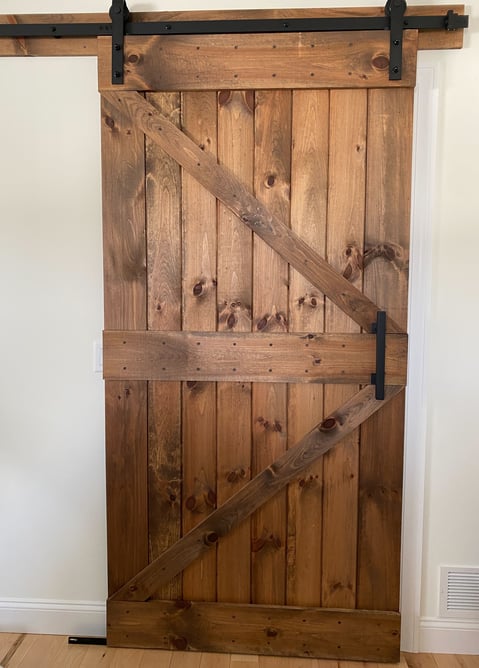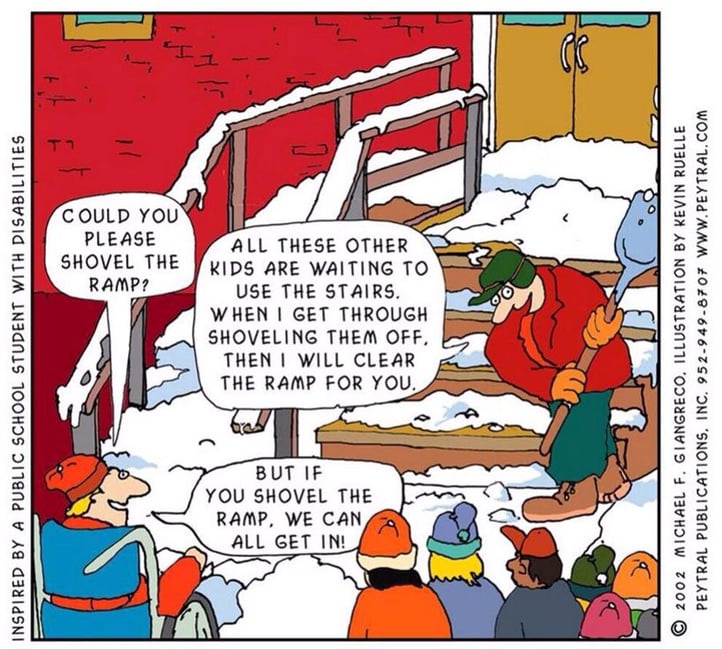%20(33).png)
Proactive Design: Planning for All
My dad is a trim carpenter. He builds a variety of furniture, custom cabinetry, and trim, and has dabbled in barn door building. We moved into our new house about a year and a half ago and I knew I wanted a barn door as an option to close off my office/playroom area from our kitchen. My dad offered to use his skills and expertise to build a custom door for this space. The challenge was the fact that the light switch is right next to the doorway and in order to slide the door fully open past the casing and the light switch, we needed an extra long track. After what seemed like endless measuring, re-measuring, confirming measurements, and taking photos, my dad felt like he had enough information to design and build our custom barn door. He got to work building the door and placed a custom order for a track that was 8 ft. long. He eagerly texted me his excitement about a “special plan” for the hardware.
As I mentioned, this room is also used as a playroom in my house. My sons are 7 and 4 and share this space with me to play with their Legos, board games, puzzles, and other toys. When my dad arrived to install our barn door, he showed me the additional piece of hardware he added to the design. This door is large and heavy and slides across an 8-foot track. As you can imagine, this has tiny, pinched fingers written all over it. My dad added a special groove to the bottom of the door with a track attached to the floor that slows down the rate of movement across the track while still maintaining the ability for my kids to independently open and close the door. My dad considered the use of the space, the individuals who would be using the door, and potential barriers to their safety and accessibility. He proactively designed for my family, to ensure that we could use this tool most effectively.
 Above is the door Ashley's father designed and built.
Above is the door Ashley's father designed and built.
When we think about our instructional design in our classrooms, we must consider the space, the learners, the content, and name and account for the potential barriers to our students’ access to learning. Often, we see what we describe as a reactive response. Meaning, sometimes the math lesson starts to go off track. The teacher feels overwhelmed or frustrated, students are confused and at times, never engaged in the first place. In these situations, we often see a reactive response. Accommodations for some are provided after the lesson in the form of alternative practice options or sitting with another adult in the room to work through the practice page. In these situations, the thinking is held by the adults and maybe SOME of the students, but definitely not all.
We want our instructional design to acknowledge and celebrate the variability of our learners from the beginning. When considering our instructional decisions, we should be changing the design of our instruction and the learning environment because we cannot and should not seek to change our learners. Consider a classroom where some students are read the problems, some students are given manipulatives and some students are offered fewer practice opportunities. All of these accommodations seem like they are meeting the variability of our students’ needs - but what message are we sending? An environment where the main lesson and practice are designed for some students while the rest of the class needs accommodations to access perpetuates the unhelpful belief system that some people are math people and some people are not. Instead, we seek to proactively design our instruction so all students can access the learning from the beginning. We love to refer to the notion of “clearing the ramps” based on this cartoon illustration by Kevin Ruelle (2002):

When we clear the ramps from the beginning, everyone can get in. When we proactively design FOR our students, we make sure everyone can access the math. It is our responsibility to ensure all students are not just in the room, but meaningfully engaged in grade-level instruction. So, how do we make that happen? Here are three critical steps to supporting proactive design:
- Use formative assessments to understand what your students know and can do independently and use that information to plan next steps. We love using the High Leverage Concepts (HLCs) Assessments, Work Sort Protocol, and HLC Progressions to help understand student thinking.
- Use Launch/Number Sense Routines to engage ALL students in the first 5-15 minutes. This discussion-rich portion of the All Learners Lesson Structure is intended to support sense-making, reasoning, and opportunities to justify our thinking. The mathematical focus is explicit and the teacher facilitates to help students make connections to important math concepts.
- Use the ALN Problem Introduction Protocol to remove barriers and increase access to problem solving. Through the PIP, we create access for every student to make sense of a written word problem and increase engagement in problem solving. We remove the barriers of language and readability and support thinking, sense-making, and visualization to support deep mathematical thinking.
When designing high-quality learning opportunities in math that are inclusive and accessible for all students, we must proactively design our instruction so that all students have an entry point and chance to productively struggle. Our instructional design should not include erasing differences to make “one-size-fits-all” lessons and assessments. Instead, we must recognize the barriers to accessing grade-level learning, highlight and celebrate our diverse interests and learning, and then design FOR them - clear the ramps. In the story I shared at the beginning, reactive design may have led to many pinched fingers, ice packs, and band-aids. Through proactive design, we name and consider the needs of our learners to remove barriers from the beginning.
Reference
Giangreco, M. F., & Ruelle, K. (2002). Clearing A Path For People With Special Needs Clear the Path For Everyone! cartoon, Peytral Publications, Inc.
Click here for the printable version.
What Now?
- Learn more about the High Leverage Concepts Resources (Concepts, Progressions, and Assessments) here and in chapters three and four of our free book.
- Increase access to problem solving by applying the ALN Problem Introduction Protocol in your classroom.
- Bring All Learners Network (ALN) into your school or district for embedded professional development.

All Learners Network is committed to a new type of math instruction. We focus on supporting pedagogy so that all students can access quality math instruction. We do this through our online platform, free resources, events, and embedded professional development. Learn more about how we work with schools and districts here.




%20(32).png?width=352&name=Hero%20Images%20(WebsiteBlogEmails)%20(32).png)
